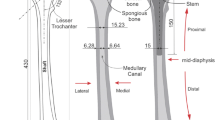Abstract
In order to simulate the osseointegration of bone implants, a bio-active interface theory is necessary. The thin bone-implant interface layer is described by the Drucker–Prager plasticity model. The formulation of bone mineral density depends on the local mechanical environment. For the simulation of the osseointegration of bone implants a bio-active interface theory is suggested. A thin bone-implant interface layer is described by a Drucker–Prager plasticity model. An evolution rule for the bone mineral density is formulated in dependency of the local mechanical environment. The time dependent ingrowth is modeled by a hardening rule which modifies the Drucker-Prager yield-surface cone in the principle stress state in dependency of the local bone mineral density. The osseointegration process is limited by the violation of a so called micromotion threshold. This relative motion in the implant-bone interface is computed by dynamic loads of daily motion activity. For parameter studies on detailed 3D models model reduction techniques are introduced. The applicability is demonstrated on a hip-joint prosthesis which is in clinical usage.
Similar content being viewed by others
References
Abdul-Kadir MR, Hansen U, Klabunde R, Lucas D, Amis A (2008) Finite element modelling of primary hip stem stability: the effect of interference fit. J Biomech 41(3): 587–594
Albrektsson T, Johansson C (2001) Osteoinduction, osteoconduction and osseointegration. Eur Spine J 10 Suppl 2: S96–S101
Andreykiv A, Prendergast PJ, van Keulen F, Swieszkowski W, Rozing PM (2005) Bone ingrowth simulation for a concept glenoid component design. J Biomech 38(5): 1023–1033
Andreykiv A, van Keulen F, Prendergast PJ (2008) Simulation of fracture healing incorporating mechanoregulation of tissue differentiation and dispersal/proliferation of cells. Biomech Model Mechanobiol 7(6): 443–461
Augat P, Burger J, Schorlemmer S, Henke T, Peraus M, Claes L (2003) Shear movement at the fracture site delays healing in a diaphyseal fracture model. J Orthop Res 21(6): 1011–1017
Bergmann G (2008). http://www.OrthoLoad.com
Büchler P, Pioletti DP, Rakotomanana LR (2003) Biphasic constitutive laws for biological interface evolution. Biomech Model Mechanobiol 1(4): 239–249
Dammak M, Shirazi-Adl A, Schwartz M, Gustavson L (1997) Friction properties at the bone-metal interface: comparison of four different porous metal surfaces. J Biomed Mater Res 35(3): 329–336
Davim JP, Marques N (2004) Dynamical experimental study of friction and wear behaviour of bovine cancellous bone sliding against a metallic counterface in a water lubricated environment. J Mater Process Technol 152(3): 389–394
Fernandes PR, Folgado J, Jacobs C, Pellegrini V (2002) A contact model with ingrowth control for bone remodelling around cementless stems. J Biomech 35: 167–176
Geris L, Sloten JV, Oosterwyck HV (2010) Connecting biology and mechanics in fracture healing: an integrated mathematical modeling framework for the study of nonunions. Biomech Model Mechanobiol
Keaveny TM, Bartel DL (1993) Effects of porous coating, with and without collar support, on early relative motion for a cementless hip prosthesis. J Biomech 26(12): 1355–1368
Kienapfel H, Sprey C, Wilke A, Griss P (1999) Implant fixation by bone ingrowth. J Arthroplasty 14(3): 355–368
Lebon F, Ronel-Idriss S (2004) Asymptotic analysis of mohr-coulomb and drucker-prager soft thin layers. Steel Compos Struct 4(2): 133–147
Lutz A, Nackenhorst U (2009) A computational approach on the osseointegration of bone implants based on a bio-active interface theory. GAMM-Mitteilungen 32(2): 178–192
Lutz A, Nackenhorst U (2009) Numerical investigations on the biomechanical compatibility of hip-joint endoprostheses. Arch Appl Mech 80: 503–512
Michalowski R, Mroz Z (1978) Associated and non-associated sliding rules in contact friction problems. Arch Mech 30: 259–276
Moreo P, Pérez M, García-Aznar J, Doblaré M (2007) Modelling the mechanical behaviour of living bony interfaces. Comput Methods Appl Mech Eng 196(35–36): 3300–3314
Nackenhorst U (2006) Computational methods for studies on the biomechanics of bones. Found Civil Environ Eng 7: 251–271
Nackenhorst U (2007) Biomechanics of Bones: Modeling and Computation of Bone Remodeling in Handbook of Biomineralization, Chapter 3, WILEY-VCH Verlag GmbH & Co. KGaA, Weinheim, pp 35–48
Onisoru J, Iarovici A, Capitanu L (2007) Finite element prediction of femoral stem osseointegration. In: Proceedings of the SISOM and Homagial Session of the Commission of Acoustics, Bucharest, pp 489–495
Papavasiliou G, Kamposiora P, Bayne SC, Felton DA (1997) 3d-fea of osseointegration percentages and patterns on implant-bone interfacial stresses. J Dent 25(6): 485–491
Pilliar RM, Lee JM, Maniatopoulos C (1986) Observations on the effect of movement on bone ingrowth into porous-surfaced implants. Clin Orthop Relat Res (208):108–113
Rungsiyakull C, Li Q, Sun G, Li W, Swain MV (2010) Surface morphology optimization for osseointegration of coated implants. Biomaterials 31(27): 7196–7204
Søballe K, Hansen ES, B-Rasmussen H, Jørgensen PH, Bnger C (1992) Tissue ingrowth into titanium and hydroxyapatite-coated implants during stable and unstable mechanical conditions. J Orthop Res 10(2): 285–299
Szmukler-Moncler S, Salama H, Reingewirtz Y, Dubruille JH (1998) Timing of loading and effect of micromotion on bone-dental implant interface: review of experimental literature. J Biomed Mater Res 43(2): 192–203
Viceconti M, Monti L, Muccini R, Bernakiewicz M, Toni A (2001) Even a thin layer of soft tissue may compromise the primary stability of cementless hip stems. Clin Biomech (Bristol, Avon) 16(9): 765–775
Author information
Authors and Affiliations
Corresponding author
Rights and permissions
About this article
Cite this article
Lutz, A., Nackenhorst, U. Numerical investigations on the osseointegration of uncemented endoprostheses based on bio-active interface theory. Comput Mech 50, 367–381 (2012). https://doi.org/10.1007/s00466-011-0635-0
Received:
Accepted:
Published:
Issue Date:
DOI: https://doi.org/10.1007/s00466-011-0635-0




